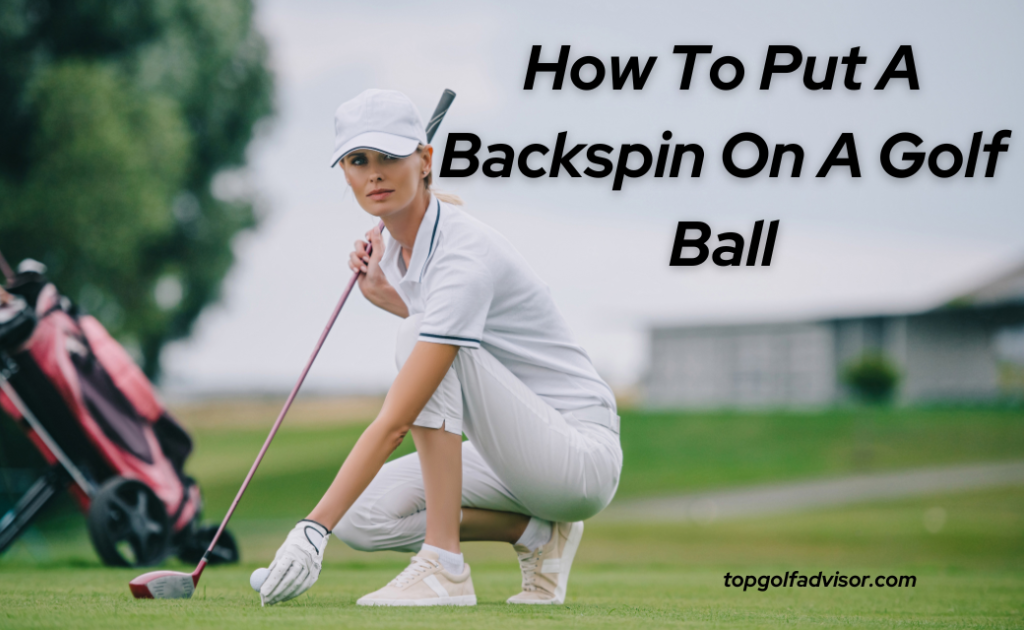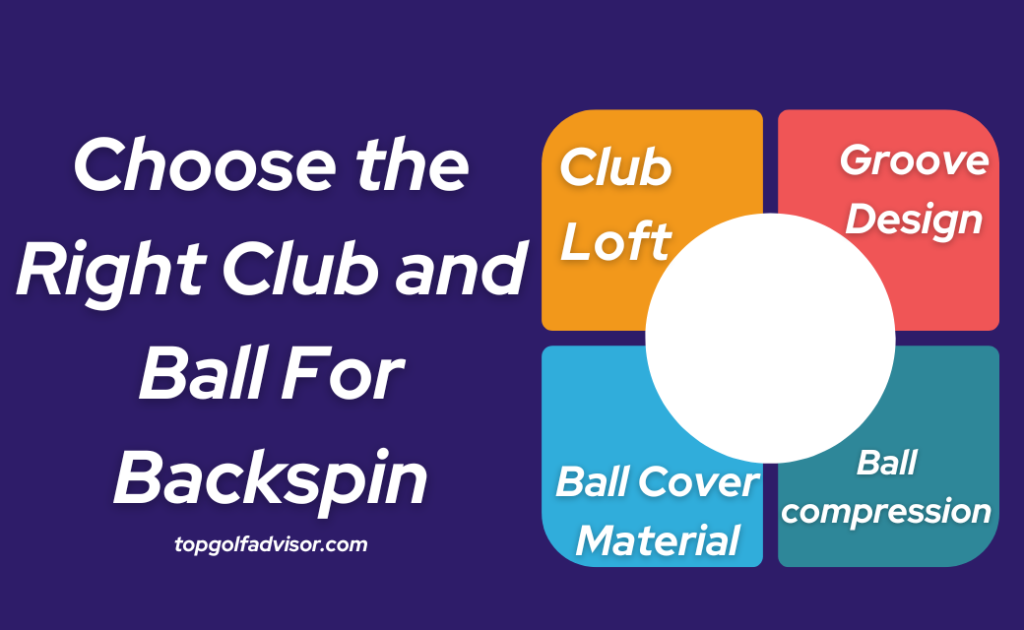How To Put Backspin On A Golf Ball?
Do you want to learn how to put backspin on a golf ball? learning this skill can not only impress your golfing buddies but also give you better control over your shots. Backspin makes it possible for the ball to halt fast after landing, allowing you to position it closer to the pin. We will walk you through the procedure step-by-step in this article.
We shall first go over the science of backspin and its significance. After that, we’ll assist you in selecting the ideal club and ball to produce spin.
After discussing proper setup and technique, we’ll go over some practice and experimentation tips for various clubface locations. Additionally, we will show you how to adjust the spin and assess your shots to make them better.
So grab your clubs and get ready to improve your game with some serious backspin!

What Goes Behind A Backspin?
A golf ball spins when it is struck by the clubface, which applies force to the ball. Backspin is produced when the ball’s upper portion spins in the opposite way of its flight, increasing lift and decreasing drag.
It’s crucial to hit the ball with a downward blow, just before the club reaches its lowest point in the swing, to produce backspin. The ball is compressed against the clubface by this downward strike, which causes friction and makes it possible for the clubface’s grooves to grasp the ball’s cover. Backspin is increased by the grooves’ assistance in gripping the ball.
The kind of ball, the clubs you use, and the speed at which you swing all affect the backspin. Softer-covered, high-spin balls typically produce more backspin. Furthermore, because wedges and lofted clubs have higher launch angles, they will assist you in producing more backspin. Finally, you can increase the amount of backspin caused by speeding up your swing.
Choose the Right Club and Ball
You must choose the right club and ball type carefully if you want to attain outstanding achievements. When selecting the appropriate club and ball, keep the following four things in mind:
- Club Loft: A key factor in producing backspin is the club’s loft. Choose a club with a greater loft since it will impart more spin to the ball when it hits the ground.
- Groove Design: Search for clubs with clubface grooves that are artistically created. By increasing friction and improving ball grip, these grooves improve spin control.
- Ball Cover Material: The ball’s cover material has a significant impact on how fast it spins. A ball with a urethane cover is a good choice since it offers superior spin and grip.
- Ball compression: The amount of ball compression during impact is the measure of ball compression. Select a ball with softer compression to produce more spin by allowing the ball to make more contact with the clubface.
You can increase the likelihood that the golf ball will acquire backspin by taking these things into account. To find the ideal fit for your playing style and ability level, don’t forget to try out different club and ball combinations.

How To Put Backspin On A Golf Ball Setting Up Properly for the Shot?
Imagine yourself poised and assured as you get ready for the shot, your body perfectly aligned with the target, and the excitement building in your muscles. To give a golf ball backspin, one must set it up correctly.
Make sure your feet are aligned to the target line and shoulder-width apart first. This will provide your swing with a solid foundation and aid in keeping your balance through the shot. For the swing to be properly executed, the load should be split equally between the two feet.
Then, if you’re a right-handed player, move the ball a little bit further back in your position and closer to your right foot. This will assist in producing the required down strike on the ball to produce backspin. To promote a descending blow, ensure that your hands are slightly in front of the ball at the address.
To ensure a fluid and controlled swing, keep your grip on the club loose. Throughout the swing, keep your arms outstretched but not rigid and your knees slightly bent. This will provide optimal control over the shot and aid in ensuring optimum power transfer.
Throughout the swing, maintain your gaze on the ball and concentrate on making clean contact. To put a backspin on a golf ball, remember that a clean, descending strike is essential. You can become proficient at this striking shot by arranging yourself correctly and using a deliberate swing.
How do you focus on a clean and solid contact?
Envision the exhilarating sensation of crisp and firm contact as you hit the ball, propelling it into the atmosphere with unforced accuracy. Concentrating on making a firm and clean touch with the ball is essential. Remember these four important points:
1. Centered Strike: Try to strike the ball in the clubface’s center. In addition to ensuring optimal energy transfer, this lowers the possibility of mishits or diversion.
2. Ball Compression: Backspin is produced by compressing the ball up against the clubface. As a result, the ball can ascend higher, hover in the air for longer, and finally come to a faster stop when it touches down.
3. Downward Strike: Providing a downward hit to the ball is critical. This facilitates clean contact and allows the club’s loft to produce the needed backspin.
4. Relaxed Grip: It might be challenging to hit the ball properly with a tight grip since it restricts the club’s range of motion. Keep your grip relaxed to ensure a clean connection and a smooth, fluid swing.
Use the Right Technique for Generating Spin
With the correct technique, you’ll be able to spin around with ease and create an enthralling dance between the ball and your club. Golf balls require the proper technique to give them backspin.
It’s crucial first to realize that hitting the ball with an open clubface and a descending blow produces a backspin. To guarantee a clean strike, keep your hands ahead of the clubhead as you swing through the ball.
The next step is accelerating the clubhead sufficiently to produce the required spin. A balanced and fluid swing will accomplish this, enabling the club to accelerate into impact. Refrain from accelerating or swinging too forcefully since this may lead to uneven contact and less spin.
Practice Your Spin Shots
You need to practice spin shots if you want to have more control and dexterity around the greens. To give a golf ball backspin, adhere to these four guidelines:
1. Clean your clubface: Make sure your clubface is clean before trying a spin shot. Debris or dirt can reduce spin by altering the amount of contact between the ball and the clubface. Use a towel or club brush to get rid of any grass or dirt.
2. Modify your setup: If you are a right-handed golfer, place the ball slightly back from your stance toward your right foot to enhance spin. As a result, the angle of attack becomes steeper and the clubface can better compress the ball.
3. Accelerate through contact: When hitting spin shots, it’s imperative to speed up through the ball at impact. This facilitates the creation of the clubhead speed required to produce spin. As you concentrate on accelerating the shaft through the impact zone, keep your swing steady and fluid.
4. Use a club with a higher loft: To improve the ball’s launch angle, use a club with a higher loft, like a lob wedge or sand wedge. On the greens, a higher launch along with a backspin will enable the ball to stop fast.
By practicing these spin shots regularly, you’ll develop the feel and technique needed to control the amount of backspin you put on the ball. Remember, it takes time and practice to master this skill, so be patient and keep at it.
Experiment with Different Clubface Positions
Examine how changing the angle at which your clubface is positioned impacts the spin and trajectory of your shots.
Trying out various clubface positions will have a big impact on how much backspin you can put on a ball.
Try slightly opening the clubface at the address to begin with. This entails turning the club’s face slightly away from your intended aim. The open clubface creates additional loft when you make contact with the ball, enabling it to take off higher into the air. Because of the greater loft, the ball has more backspin as it lands, which causes it to stop sooner.
Alternatively, you might try shutting the clubface at the address to lessen the amount of backspin. This entails turning the club’s face slightly in the direction of your aim. A lower launch angle and reduced backspin on the ball are the results of closing the clubface, which lowers the loft at contact. When you want to play longer shots that spread out more on the fairway, this can help. Also check our article on How Many Balls Are In A Box Of Golf Balls for more information about number of balls in a box.
Final Words
In conclusion, choosing the appropriate club and ball, setting yourself up for the shot, and knowing the science behind backspin all contribute to the art of how to put a backspin on a golf ball.
You can get better at the game by practicing spin strokes, employing proper technique, and concentrating on making clean and robust contact. You may improve your game by experimenting with different clubface locations and mastering spin control.
You can soon add outstanding backspin to your golf swings with consistent analysis and adjustment.
FAQs
How much backspin is considered ideal for a golf shot?
The ideal amount of backspin for a golf shot varies depending on the situation. Generally, a moderate amount of backspin helps control the ball’s flight and allows it to stop quickly on the green.
Can backspin be generated with any type of golf ball?
Yes, backspin can be generated with any type of golf ball. The key is to create a steep angle of attack and strike the ball cleanly and with enough speed to create the necessary spin.
Is it possible to generate backspin with any club in the golf bag?
Yes, generating backspin with any club in your golf bag is possible. By using the right technique and striking the ball cleanly, you can create a backspin and control the ball’s trajectory.
Are there any specific factors that can affect the amount of backspin generated?
Factors such as club loft, clubhead speed, and the condition of the golf ball can affect the amount of backspin generated. Higher club lofts, faster clubhead speeds, and a well-maintained ball can increase backspin.
